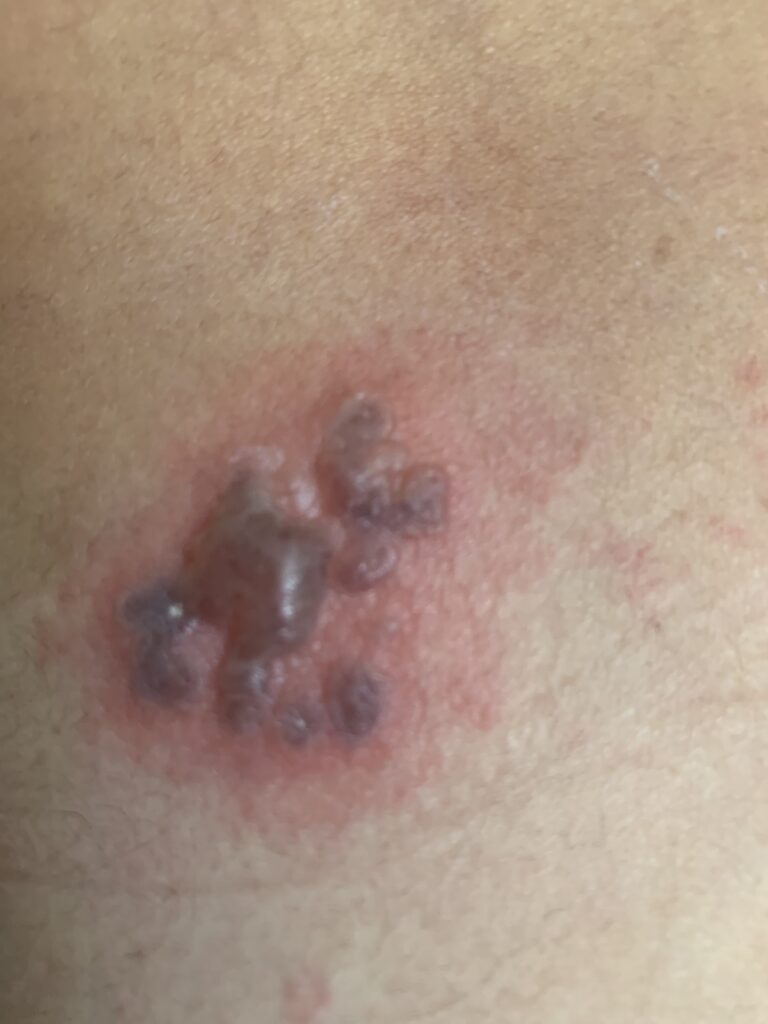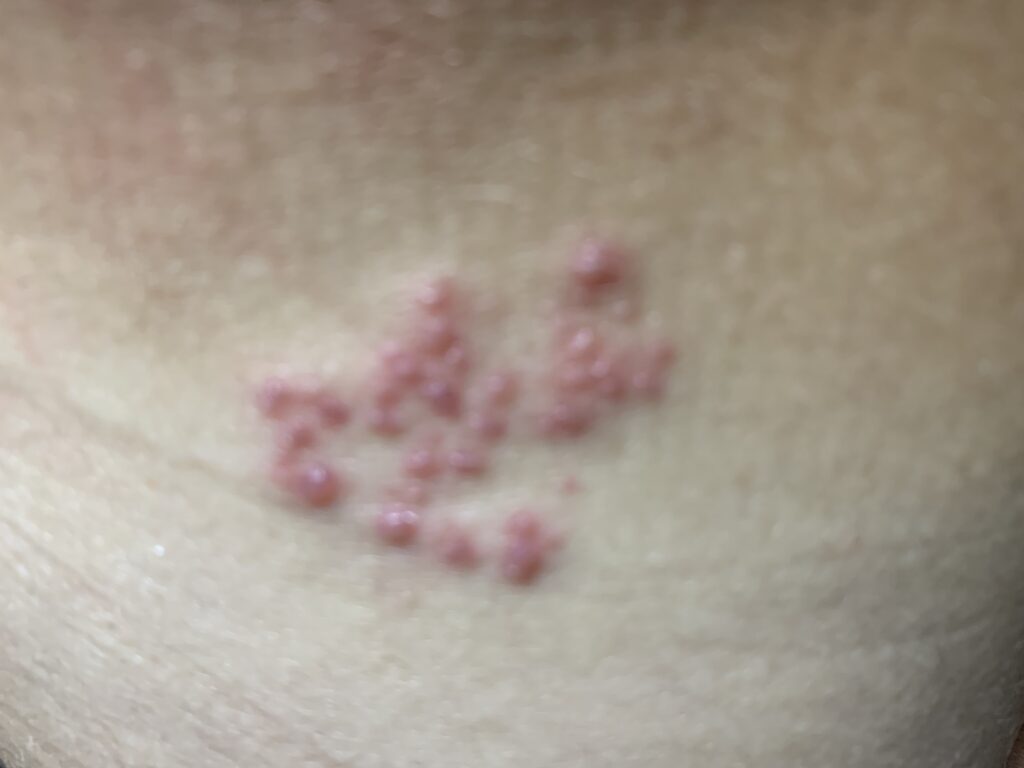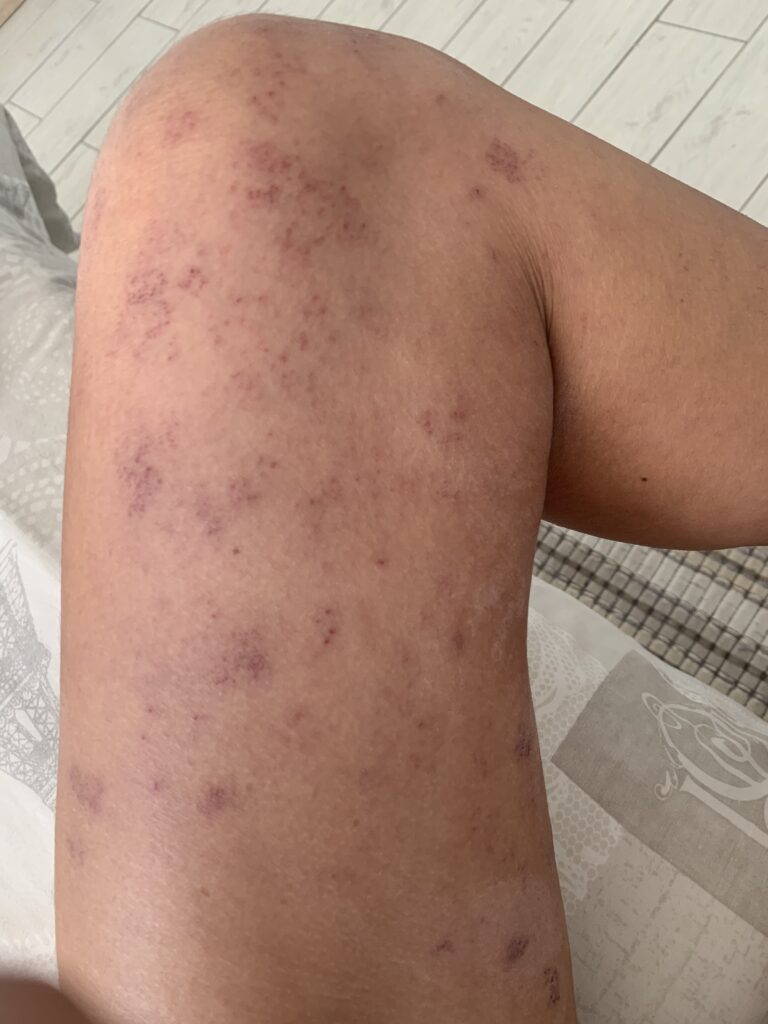Shingles is not something I wish upon anyone at any time. Dealing with shingles and pain, especially before the most beautiful time of the year, when everyone expects you to be joyful and merry, is not easy.
Christmas time is approaching, and I’m excited about the lights, the food, and the family time. I leave many of the Christmas preparations to the last minute. I did not imagine that at the last minute, I would be dealing with shingles instead.
Understanding Shingles and its Impact on Your Holiday Season
shingles, holiday season, managing shingles pain, symptoms of shingles, shingles before Christmas
Varicella-zoster virus (VZV) belongs to the herpesvirus group. When you first come in contact with the virus, you get chickenpox. Chickenpox is also known as varicella, and this is the primary infection. VZV can remain dormant for decades. VZV remains in the body in an inactive form after the primary disease, and It lives inside the sensory ganglia of spinal/cranial nerves.
When reactivated, VZV causes a secondary infection. This infection is very different from chickenpox and goes by the name shingles.
Shingles is an excruciating, self-limited rash with blisters. It causes sudden nerve pain, sometimes so intense that it can be debilitating.
The 3 phases of shingles infection:
Phase 1: Pre-eruptive phase (1-4 days or up to 10 days)
This initial phase has the following characteristics:
- Pre-herpetic neuralgia – nerve pain before the eruption of the vesicles/blisters.
- Pain only in 1 or more dermatomes. Dermatomes are like a map of areas of skin that rely on specific nerve connections on the spine.
- Feelings of stabbing, burning, numbness, tingling.
- The affected area is sensitive to touch.
- Other symptoms of shingles can include fatigue, general feeling of unwellness, and fever.
Phase 2: Acute eruptive phase (2-3 days)
The middle phase includes the following:
- The rash starts as small red dots.
- Painful skin rash.
- Develop into fluid-filled blisters.
- Fluid-filled blisters in clusters.
- Erythematous base (“patchy rash”).
- Blisters follow the nerve path.
- Form a stripe on one side of the body.
- Blisters dry out and crust over.
- The rash doesn’t cross the midline.

Phase 3: Chronic Phase (30 days or more or even years)
The last phase of the shingles infection is the hardest and longest:
- Healing can take several weeks.
- No cure.
- Post-herpetic neuralgia (nerve pain)/pruritus (itchiness) can develop as the main complication.
- Persistent or recurring pain from a scale of mild to severe.
- pain occurs in the area of the prior acute eruption.
- At the site of the rash, scarring can occur.

Any factor that suppresses and weakens your immune system reactivates the dormant VZV.
VZV multiplies and spreads along the path of the infected nerve. It results in inflammation and, thus, damage to the nerve fibres. Damaged nerve fibres send exaggerated pain messages from the skin to the brain.
The location of pain can vary according to the nerve that it affects. Each spinal nerve supplies a specific body area known as the dermatome. The pattern of pain follows the dermatome distribution. This means that the experience of shingles can vary from person to person.
When a cranial nerve is the target, you will experience face pain. As nerves come in pairs and usually only one is affected, the pain is limited to a small area on one side of the body. The same applies to the visible rash after you feel pain. The rash never crosses the midline. It is confined to only one side of the body. This is a typical diagnostic characteristic of shingles.
If shingles appear on the face, neck or scalp, it is more severe due to the risk of vision loss and hearing loss. In rare cases, facial paralysis and encephalitis (swelling of the brain) can take place.
The following are risk factors for the occurrence of shingles:
- Increasing age (risk of developing shingles increases after age 50).
- Stress.
- Immunosuppressive medications such as corticosteroids.
- Immunocompromised conditions, such as AIDS and cancers.
- Transplant patients due to immunosuppressive medications needed to prevent organ rejection.
- Autoimmune conditions – issues with the immune system in general.
- The female gender is more susceptible to autoimmune conditions.
- People of European descent are more prone to shingles.
- Chronic disease states (e.g. Lung or kidney disease). Extensive systemic conditions that can lead to an immunocompromised state.
- Physical injury in a specific area can affect the nerves in the injured person or dermatome. Thus reactivating the dormant VZV.
Despite being a female of European descent, I’m only in my 40s. I’m convinced my shingles were due to the cortisone and antihistamine treatments that I’ve been on. These treatments weakened my immune system. I wish my family doctor had alerted me to the possibility of shingles.
My story dealing with Shingles before Christmas
Three days before Christmas Eve, I felt a cluster of pimples in the back of my left-hand-side torso.

I dismissed it as another allergic reaction to some insect bite. Later that evening, a pulling nerve pain appeared behind my left knee. This pain found its way up my thigh.
I was uncomfortable in any position, but I got through the night. The next day, I felt extreme sensitivity along my left leg. Unfortunately, I continued with all these new sensations and discomfort for three days. A rash later appeared along the inside of my left thigh.

By the 24th of December, the pain around my hip was so intense that I thought I couldn’t walk. It brought me to tears, and I knew that I had to see a Dr straight away. I should have gone sooner to prevent post-herpetic neuralgia (PHN).
PHN is the most common complication of shingles. It is a persistent burning pain in the muscle nerves and skin. The worst thing is that it can last long after the rash and blisters disappear. The risk of PHN increases with age and delayed medical intervention. Pain persists for 30 days or more in up to 50% of cases.
Tips for Dealing with Shingles Discomfort During the Festive Season
treatment for shingles pain, home remedies for shingles, pain management during holidays, holiday activities while dealing with shingles
1. Prioritising Rest and Self-Care
resting with shingles, self-care during holidays, relaxation techniques for managing pain
I found rest to be of utmost importance during the festive season.
After pulling off a beautiful and tasty Christmas Eve dinner, I spent Christmas Day and Boxing Day in bed. Unfortunately, I felt very nauseous and lost my appetite the day after I began my treatment.
The pain caused by shingles remains after you start treatment. In my case, treatment happened four days after the onset of the rash, I can expect complications.
It’s essential to take the prescribed anti-viral tablets and a mood stabiliser. At a low dose, a mood stabiliser, such as Trepiline, can treat pain, especially pain caused by nerve damage.
While dealing with shingles, I cleaned my rash twice daily with lukewarm water. Followed by a calamine lotion application to reduce itchiness.
2. Communicating with Loved Ones about Your Condition
talking to family about shingle symptoms, support from loved ones during holidays
The discomfort caused by shingles is no joke. Your loved ones and those you spend the holidays with must know that.
There is no better time to receive tender love and care than when you have shingles.
Your loved ones must understand that you must be stress-free and comfortable.
You may have to delegate. You may have to trust that the people around you will help you achieve the same results. Results for a memorable, peaceful, well-spent Christmas while dealing with shingles.
3. Modifying Holiday Plans to Cut Stress and Physical Strain
holiday planning with shingles, reducing stress during festivities, adapting activities for comfort
This year, we had no plans of being away from home on a camping trip or sailboat. It helped that my Christmas dealing with shingles was in the comfort of my home.
One thing I love, and I’ve had to give up during this holiday season, was wine—anything to avoid interference with my treatment while dealing with shingles.
My husband got on my nerves, to be honest, every time he offered me wine during this time. He didn’t understand he was not helping me dealing with shingles. This goes back to point 2 above, communicating with loved ones about this condition.
4. Seeking Medical Advice and Treatment Options
talking to a doctor about shingle treatment options, anti-viral medication for shingle relief
If I knew what I know now, I would not have allowed the infection to progress as far as it did. To anyone reading this blog, seek medical intervention as soon as possible. If you see or feel an unusual rash or a cluster of pimples that don’t cross the midline together with pain, chances are it’s shingles.
The sooner you start on the anti-viral medication, the better your outcome. The shorter your discomfort, pain, and suffering while dealing with shingles.
Here’s a list of some treatment options when dealing with shingles:
- Anti-viral medications. Starting within three days of onset is ideal to reduce the risk of complications.
- PHN: Pain relievers/ analgesics are helpful.
- Cold baths or cool compresses to ease the pain and itchiness.
- Affected areas must be clean (to prevent infection) and covered (to prevent spreading).
Maintaining Emotional Well-being While Dealing with Shingles Symptoms
coping with shingle pain during the Christmas season, seeking support groups or therapy
The pain is real, persistent, like a throbbing dagger pocking under your skin.
My husband cooked the most fantastic biryani chicken rice one night. I took two or three fork-spoons of the lovely curry.
Straight after, the throbbing tingling under my skin became more intense. I googled “shingles and curry”; unfortunately, these don’t go well together when dealing with shingles.
Certain curry ingredients contain compounds that stimulate nerve endings. This causes an increase in the blood flow to the skin. As a result, the burning, itching, or pain sensations associated with shingles intensifies.
One needs to sacrifice some of our favourite things to promote recovery. The downside is that it is not a speedy recovery, no matter what you do or give up. Patience and perseverance are essential, as well as maintaining emotional well-being when dealing with shingles.
If I hadn’t taken a small dose of trepiline while dealing with shingles, I would not have managed my shingles pain during phase two as well as I did. Ten days later, my leg is weak, and the throbbing pain, together with itchiness, is driving me crazy.
Savouring the Holiday Spirit Despite Shingle Setback: Ideas for Celebrating at Home
festive at-home activities while recovering from shingles, enjoying virtual celebrations
I spent two full days in bed over Christmas. I watched every Christmas movie on Netflix.
Watching movies helped me switch off from my uncomfortable shingles setback.
I enjoyed relaxing while watching entertaining movies that lifted my holiday spirit.
I also enjoyed reading my books and drinking lots of honey-flavoured green tea while dealing with shingles.
Conclusion: Don’t Let Shingles Dampen Your Holiday Spirit – Take Care and Seek Support
managing shingles during holidays, staying positive during shingle recovery, finding joy despite shingle symptoms
Stopping shingles from dampening your holiday spirit is easier said than done. But it is not impossible.
It’s essential to follow all the above tips for dealing with shingles and the discomfort that comes with them. It helps if you stay proactive and busy within limits. Activity helps to take your mind off the irritating itchiness or the burning pain.
Support from friends and family is also beneficial when dealing with shingles
Encouragement eases the setback that dealing with shingles bring to your life.
Most people only get shingles once, but getting it more than once is not uncommon.
Shingles prevention is possible with the Shingrix vaccine.
Please consult your medical care practitioner to find out more about dealing with shingles.
After all, Christmas time should be full of joy, jingles and not shingles!


A personal journey
I am really inspired with your writing abilities and also with the format for your blog. Is that this a paid subject or did you customize it your self? Either way keep up the excellent high quality writing, it’s rare to see a great weblog like this one today!